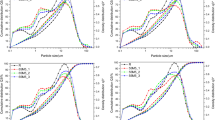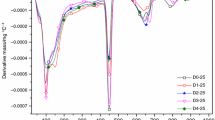Abstract
In the present study, hydration of four-compound systems consisting of Portland cement and three supplementary cementitious materials : silica fume, blast-furnace slag, and metakaolin, has been investigated by means of isothermal calorimetry and thermal analysis. Substitution of Portland cement was achieved at 25, 30, and 35 mass% by cementitious supplementary materials. Owing to the high specific surface, the silica fume eventuated in more distinctive demonstration of pozzolanic reactions. It decreased C/S ratio and led to the formation of hydration phases with C/S ≅ 1, which is demonstrated by wollastonite crystallization at higher temperatures. Enhanced formation of gehlenite hydrate was proved by DTG when blended cements included higher content of metakaolin and blast-furnace slag. Pozzolanic materials increased the compressive strength of particular blended samples and thus overcame the dilution effect especially at long term of curing. Presented quaternary blended samples in comparison with ordinary Portland cement thus allowed the formation of more thermal stable hydration products and can be considered as promising materials for the development of special concrete also for hydrothermal applications.











Similar content being viewed by others
References
Antoni M, Rossen J, Martirena F, Scrivener K. Cement substitution by a combination of metakaolin and limestone. Cem Concr Res. 2012;42:1579–89.
Moulin E, Blanc P, Sorrentino D. Influence of key cement chemical parameters on the properties of metakaolin. Cem Concr Compos. 2001;23:463–9.
Rahhal V, Cabrera O, Talero R, Delgado A. Calorimetry of portland cement with silica fume and gypsum additions. J Therm Anal Calorim. 2007;87(2):331–6.
Opravil T, Ptaček P, Šoukal F, Havlica J, Brandštetr J. The synthesis and characterization of an expansive admixture for M-type cements I. The influence of free CaO to the formation of ettringite. J Therm Anal Calorim. 2013;111:517–26.
Feng J, Liu S, Wang Z. Effects of ultrafine fly ash on the properties of high-strength concrete. J Therm Anal Calorim. 2015;121:1213–23.
Moser RD, Jayapalan AR, Garas VY, Kurtis KE. Assessment of binary and ternary blends of metakaolin and Class C fly ash for alkali-silica reaction mitigation in concrete. Cem Concr Res. 2010;40:1664–72.
Snelson DG, Wild S, O’Farrell M. Heat of hydration of Portland Cement–Metakaolin–Fly ash (PC–MK–PFA) blends. Cem Concr Res. 2008;38:832–40.
Li Z, Ding Z. Property improvement of Portland cement by incorporating with metakaolin and slag. Cem Concr Res. 2003;33:579–84.
Maheswaran S, Iyer NR, Palani GS, Alagu Pandi R, Divina Dikar D, Kalaiselvam S. Effect of high temperature on the properties of ternary blended cement pastes and mortars. J Therm Anal Calorim. 2015;122:775–86.
Torréns-Martín D, Fernández-Carrasco L, Blanco-Varela MT. Thermal analysis of blended cements. J Therm Anal Calorim. 2015;121:1197–204.
Poona CS, Lama L, Koua SC, Wonga YL, Wong R. Rate of pozzolanic reaction of metakaolin in high-performance cement pastes. Cem Concr Res. 2001;31:1301–6.
Curcio F, Deangelis BA, Pagliolico S. Metakaolin as a pozzolanic microfiller for high-performance mortars. Cem Concr Res. 1998;28(6):803–9.
Chen Y, Gu D. Selection of superplasticizer for high performance concrete. Concrete. 1997;5:28–31.
Frias M, Cabrera J. Pore size distribution and degree of hydration of metakaolin–cement pastes. Cem Concr Res. 2000;30(4):561–9.
Sonebi M, Lachemi M, Hossain KMA. Optimisation of rheological parameters and mechanical properties of superplasticised cement grouts containing metakaolin and viscosity modifying admixture. Constr Build Mater. 2013;38:126–38.
Khan SU, Nuruddin MF, Ayub T, Shafiq N. Effects of different mineral admixtures on the properties of fresh concrete. Hindawi Publishing Corporation. Sci World J. 2014;. doi:10.1155/2014/986567.
Largent R. Evaluation of pozzolanic activity-attempt at finding a test. Bulletin De Liaison Des Lab Des Ponts Et Chaussees; 1978. pp. 61–65.
Duan P, Shui Z, Chen W, Shen C. Effects of metakaolin, silica fume and slag on pore structure, interfacial transition zone and compressive strength of concrete. Constr Build Mater. 2013;44:1–6.
Zhang T, Yu O, Wei J, Gao P, Zhang P. Study on optimization of hydration process of blended cement. J Therm Anal Calorim. 2012;107:489–98.
Wild S, Khatib JM, Jones A. Relative strength, pozzolanic activity and cement hydration in superplasticised metakaolin concrete. Cem Concr Res. 1996;26(10):1537–44.
Menzel CA. Strength and volume change of steam-cured portland cement mortar and concrete. J Am Concr I. 1934;31:221–44.
Mitsuda T, Kobayakawa S, Toraya H. Characterization of hydrothermally formed C–S–H. In: Proceedings of the eighth international congress of the chemistry of cement, Rio de Janeiro; 1986.
Palou M, Živica V, Ifka T, Boháč M, Zmrzly M. Effect of hydrothermal curing on early hydration of G-Oil well cement. J Therm Anal Calorim. 2014;116(2):597–603.
Palou MT, Šoukal F, Boháč M, Šiler P, Ifka T, Živica V. Performance of G-Oil well cement exposed to elevated hydrothermal curing conditions. J Therm Anal Calorim. 2014;118:865–74.
Boháč M, Palou M, Novotný R, Másilko J, Všianský D, Staněk T. Investigation on early hydration of ternary Portland cement-blast-furnace slag-metakaolin blends. Constr Build Mater. 2014;64:333–41.
Mostafa NY, Brown PW. Heat of hydration of high reactive pozzolans in blended cements: isothermal conduction calorimetry. Thermochim Acta. 2005;435:162–7.
Sanchez de Rojas M, Frias M. The pozzolanic activity of different materials, its influence on the hydration heat in mortars. Cem Concr Res. 1996;26(2):203–13.
Silica Fume Association: silica fume manual. 38860 Sierra Lane, Lovettsville, VA 20180, USA; 2005.
Siler P, Kratky J, De Belie N. Isothermal and solution calorimetry to assess the effect of superplasticizers and mineral admixtures on cement hydration. J Therm Anal Calorim. 2012;107:303–13.
Walker R, Pavía S. Physical properties and reactivity of pozzolans, and their influence on the properties of lime–pozzolan pastes. Mater Struct. 2011;44:1139–50.
Krajči Ľ, Janotka I, Puertas F, Palacios M, Kuliffayová M. Long-term properties of cement composites with various metakaolin content. Ceram-Silik. 2013;57(1):74–81.
Coleman NJ, McWhinnie WR. The solid state chemistry of metakaolin-blended ordinary Portland cement. J Mater Sci. 2000;35(11):2701–10.
Changling H, Osbaeck B, Makovicky E. Pozzolanic reaction of six principal clay minerals: activation reactivity assessments and technological effects. Cem Concr Res. 1995;25(8):1691–702.
Prince W, Edwards-Lajnef M, Aïtcin P-C. Interaction between ettringite and a polynaphthalene sulfonate superplasticizer in a cementitious paste. Cem Concr Res. 2002;32:79–85.
Talero R. Comparative XRD analysis ettringite originating from pozzolan and from portland cement. Cem Concr Res. 1996;26(8):1277–83.
Lagier F, Kurtis KE. Influence of Portland cement composition on early age reactions with metakaolin. Cem Concr Res. 2007;37:1411–7.
Knudsen T. The dispersion model for hydration of portland cement 1. General concepts. Cem Concr Res. 1984;14:622–30.
Rahhal VF, Irassar EF, Trezza MA, Bonavetti VL. Calorimetric characterization of Portland limestone cement produced by intergrinding. J Therm Anal Calorim. 2012;109:153–61.
Malhotra VM, Mehta PK. Pozzolanic and cementitious materials. Amsterdam: Gordon and Breach Publishers; 1996.
Fares H, Remond S, Noumowe A, Cousture A. High temperature behavior of self-consolidating concrete microstructure and physicochemical properties. Cem Concr Res. 2010;40:488–96.
Ibrahim IA, ElSersy HH, Abadir MF. The use of thermal analysis in the approximate determination of the cement content in concrete. J Therm Anal Calorim. 2004;76:713–8.
Silva de Souzab LM, Fairbairn EMR, Filho RDT, Cordeiro GC. Influence of initial CaO/SiO2 ratio on the hydration of rice husk ash-Ca(OH)2 and sugar cane bagasse ash-Ca(OH)2 pastes. Quim Nova. 2014;37(10):1600–5.
Bažant ZP, Kaplan MF. Concrete at high temperatures. London: Longman Addison-Wesley; 1996.
Matsushita F, Aono Y, Shibata S. Carbonation degree of autoclaved aerated concrete. Cem Concr Res. 2000;30:1741–5.
Kuliffayová M, Krajči Ľ, Janotka I, Šmatko V. Thermal behaviour and characterization of cement composites with burnt kaolin sand. J Therm Anal Calorim. 2012;108:425–32.
Habert G, Choupay N, Montel JM, Guillaume D, Escadeillas G. Effects of the secondary minerals of the pozzolans on their Pozzolanic activity. Cem Concr Res. 2008;7:963–75.
Acknowledgements
This work was supported by courtesy of the Slovak Grant Agency VEGA Nos. 2/0082/14, 1/0696/15 and by the project Sustainability and Development REG LO1211 addressed to the Materials Research Center at FCH VUT.
Author information
Authors and Affiliations
Corresponding author
Additional information
Cement nomenclature is used when C = CaO, S = SiO2, A = Al2O3, F = Fe2O3, \( {\bar{\text{S}}} \) = SO3, H = H2O.
Rights and permissions
About this article
Cite this article
Palou, M.T., Kuzielová, E., Novotný, R. et al. Blended cements consisting of Portland cement–slag–silica fume–metakaolin system. J Therm Anal Calorim 125, 1025–1034 (2016). https://doi.org/10.1007/s10973-016-5399-5
Received:
Accepted:
Published:
Issue Date:
DOI: https://doi.org/10.1007/s10973-016-5399-5




